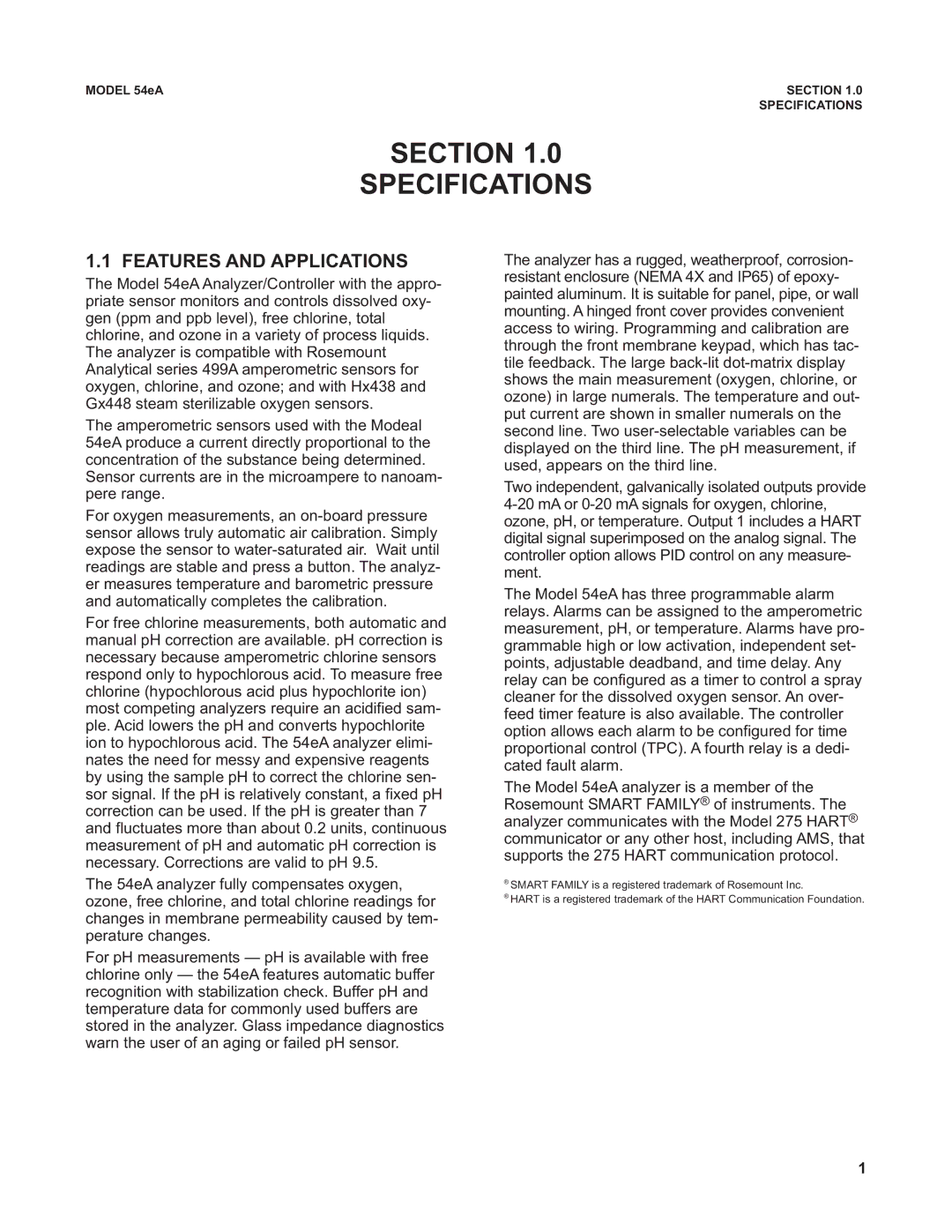MODEL 54eA | SECTION 1.0 |
| SPECIFICATIONS |
SECTION 1.0
SPECIFICATIONS
1.1 FEATURES AND APPLICATIONS
The Model 54eA Analyzer/Controller with the appro- priate sensor monitors and controls dissolved oxy- gen (ppm and ppb level), free chlorine, total chlorine, and ozone in a variety of process liquids. The analyzer is compatible with Rosemount Analytical series 499A amperometric sensors for oxygen, chlorine, and ozone; and with Hx438 and Gx448 steam sterilizable oxygen sensors.
The amperometric sensors used with the Modeal 54eA produce a current directly proportional to the concentration of the substance being determined.
Sensor currents are in the microampere to nanoam- pere range.
For oxygen measurements, an
For free chlorine measurements, both automatic and manual pH correction are available. pH correction is necessary because amperometric chlorine sensors respond only to hypochlorous acid. To measure free chlorine (hypochlorous acid plus hypochlorite ion) most competing analyzers require an acidified sam- ple. Acid lowers the pH and converts hypochlorite ion to hypochlorous acid. The 54eA analyzer elimi- nates the need for messy and expensive reagents by using the sample pH to correct the chlorine sen- sor signal. If the pH is relatively constant, a fixed pH correction can be used. If the pH is greater than 7 and fluctuates more than about 0.2 units, continuous measurement of pH and automatic pH correction is necessary. Corrections are valid to pH 9.5.
The 54eA analyzer fully compensates oxygen, ozone, free chlorine, and total chlorine readings for changes in membrane permeability caused by tem- perature changes.
For pH measurements — pH is available with free chlorine only — the 54eA features automatic buffer recognition with stabilization check. Buffer pH and temperature data for commonly used buffers are stored in the analyzer. Glass impedance diagnostics warn the user of an aging or failed pH sensor.
The analyzer has a rugged, weatherproof, corrosion- resistant enclosure (NEMA 4X and IP65) of epoxy- painted aluminum. It is suitable for panel, pipe, or wall mounting. A hinged front cover provides convenient access to wiring. Programming and calibration are through the front membrane keypad, which has tac- tile feedback. The large
Two independent, galvanically isolated outputs provide
The Model 54eA has three programmable alarm relays. Alarms can be assigned to the amperometric measurement, pH, or temperature. Alarms have pro- grammable high or low activation, independent set- points, adjustable deadband, and time delay. Any relay can be configured as a timer to control a spray cleaner for the dissolved oxygen sensor. An over- feed timer feature is also available. The controller option allows each alarm to be configured for time proportional control (TPC). A fourth relay is a dedi- cated fault alarm.
The Model 54eA analyzer is a member of the Rosemount SMART FAMILY® of instruments. The analyzer communicates with the Model 275 HART® communicator or any other host, including AMS, that supports the 275 HART communication protocol.
®SMART FAMILY is a registered trademark of Rosemount Inc.
®HART is a registered trademark of the HART Communication Foundation.
1
